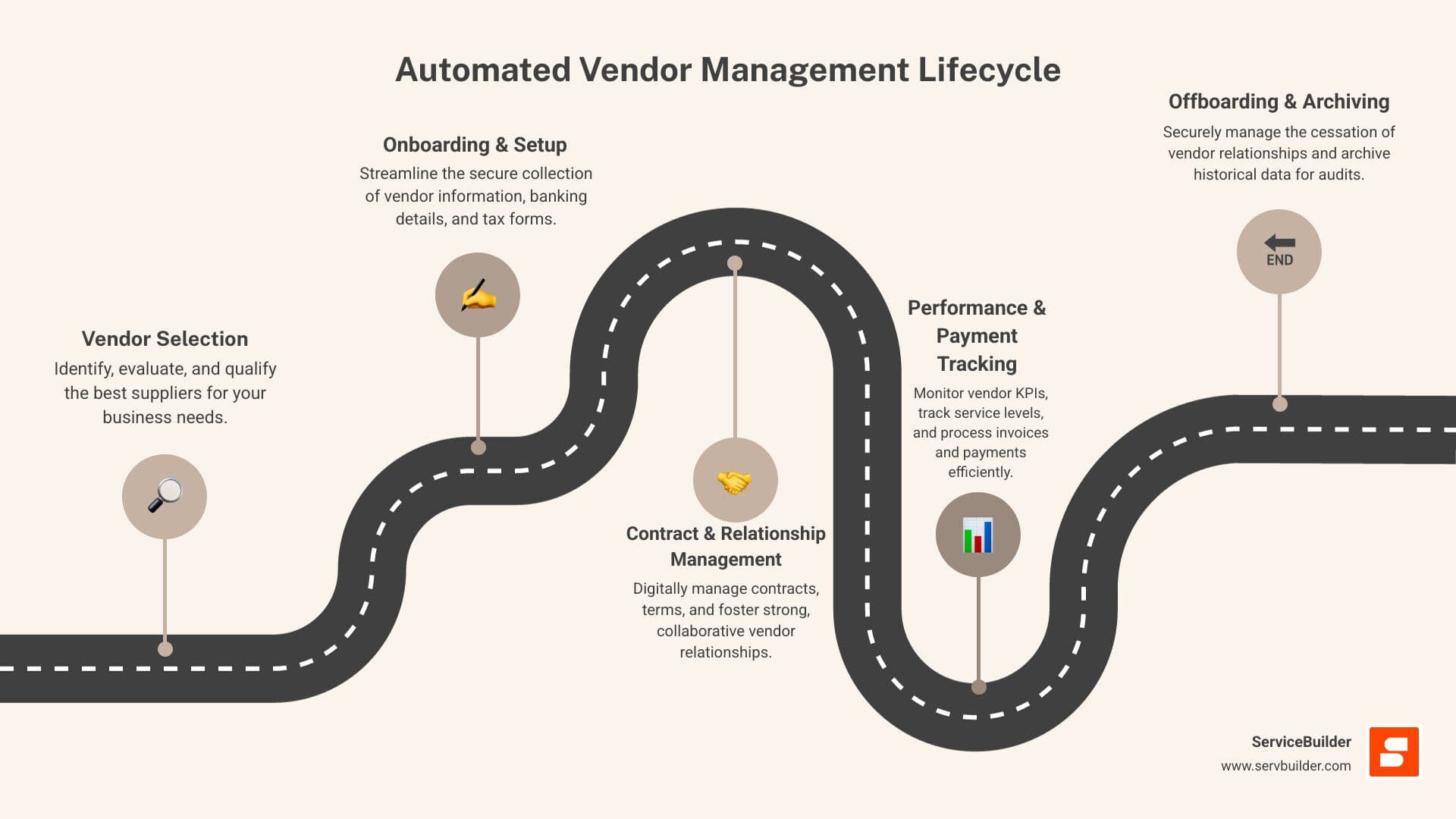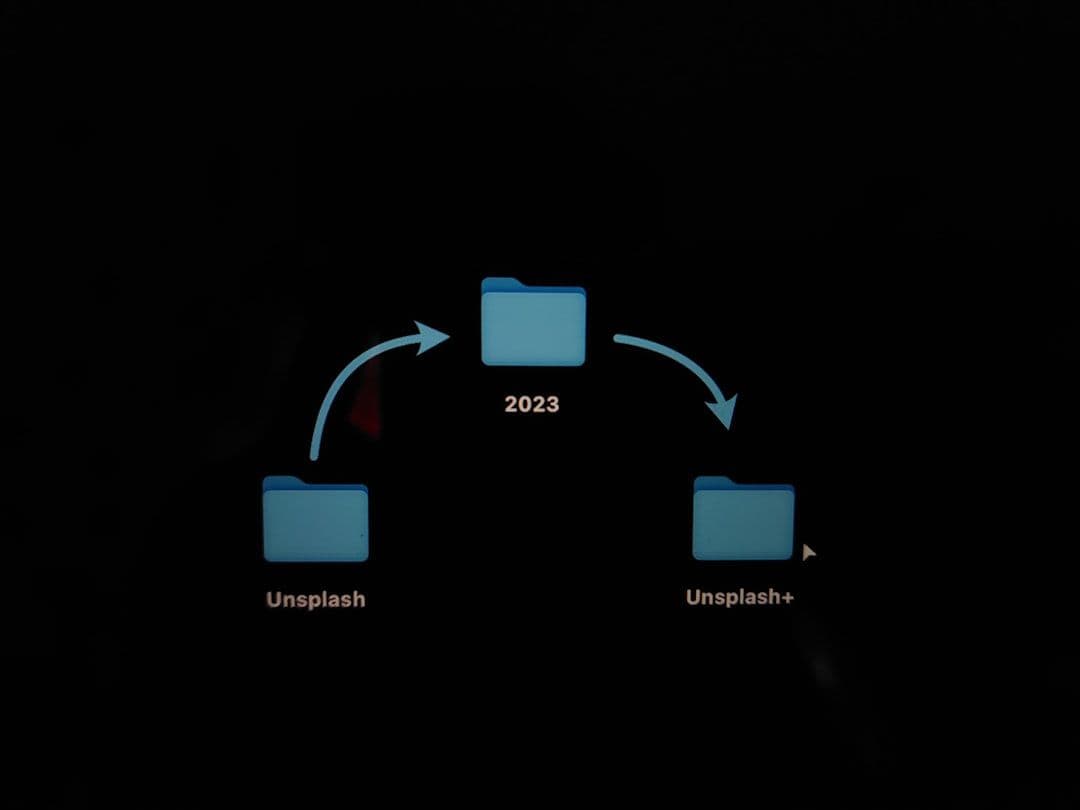Why Automated Vendor Management Systems Are a Game-Changer
- Andrew Leger
Why Automated Vendor Management Is a Game-Changer¶
An automated vendor management system is a specialized software solution designed to streamline and centralize all aspects of managing your business's vendors.
This powerful tool helps you:
Onboard new vendors quickly and compliantly.
Track performance and ensure quality.
Manage contracts and renewals effortlessly.
Process payments efficiently.
Reduce risks like data breaches and compliance failures.
For service business owners, managing vendors can feel like herding cats. You're juggling spreadsheets, emails, and phone calls just to keep track of who does what, when, and for how much. This manual approach leads to missed deadlines, wasted money, and a lot of unnecessary stress.
The good news? You don't have to manage your vendors this way anymore.
The vendor management software market is growing fast, expected to hit $17.2 billion by 2030. This growth shows that businesses recognize a crucial truth: automating vendor management isn't just about making things easier. It's about turning a challenge into a major competitive advantage. By doing so, you gain better control, cut costs, and free up valuable time.
You'll find how an automated system makes your business more efficient, reduces risks, and improves how you work with every supplier and contractor.
Andrew Leger is a software engineering leader with over 15 years of experience building enterprise-grade systems. His background has provided deep insight into automating complex workflows, including those best managed by an automated vendor management system, across diverse industries.

What Is an Automated Vendor Management System and Why Is It Crucial?¶

An automated vendor management system (VMS) is a cloud-based software platform that acts as a central command center for all vendor-related activities. It replaces manual methods like spreadsheets and email chains, which often lead to fragmented information, errors, and a lack of visibility into your vendor network. This lack of control can lead to significant risks, including unapproved software ("Shadow IT") and costly data breaches. With 31% of cyber insurance claims involving third-party risks, a VMS is crucial for modern Operations Management and Supply Chain Management.
Streamline the Entire Vendor Lifecycle¶
A VMS automates the entire vendor journey, turning a series of manual tasks into a seamless, efficient process. It supports every stage:
Selection & Negotiation: Easily find, compare, and select vendors using centralized data. Access performance history to negotiate better contracts.
Onboarding: Automate document collection and verification for a Streamlined onboarding experience.
Performance & Payment: Continuously monitor vendor performance against goals and integrate with financial tools for timely, accurate payments.
Offboarding: Ensure smooth and compliant offboarding, including final payments and record-keeping. This end-to-end automation, similar to an Automated Business Process Workflow, frees your team to focus on strategic growth.
Mitigate Risk and Ensure Compliance¶
In a world of increasing regulation, a VMS is your digital shield. Manual risk management is no longer viable due to the volume of sensitive data, complex rules (like GDPR or SOC 2), and the sheer number of vendors. An automated system provides:
Improved Data Security: Centralized, secure storage for contracts and payment details protects against data leaks.
Automated Compliance: The system automatically tracks licenses, certifications, and insurance, which is critical for field service businesses requiring specific contractor credentials. It helps Ensure vendor compliance with GDPR regulations.
Robust Audit Trails: Every action is recorded, creating a clear history for internal reviews or regulatory audits.
Real-time Risk Monitoring: The system can flag changes in a vendor's financial health or security status, allowing you to address potential issues proactively.
7 Key Benefits of Automating Vendor Management¶

An automated vendor management system isn't just about convenience; it drives measurable improvements across your organization by increasing efficiency, enabling data-driven decisions, and sharpening your strategic focus. Let's explore the key benefits.
1. Significant Cost Reduction¶
An automated vendor management system immediately slashes costs. By automating routine tasks like data entry and invoice processing, you reduce administrative overhead. Companies using automation have seen a 15–25% reduction in procurement costs. Automated payment workflows eliminate late fees and preserve your financial reputation. With clear spend visibility, you can identify opportunities for consolidating purchases and negotiating bulk discounts. This efficiency mirrors the benefits of Automated Expense Management Tools.
2. Improved Operational Efficiency¶
Beyond cost savings, a VMS makes daily operations smoother and faster. Automated workflows eliminate bottlenecks in approvals and onboarding. Automation also minimizes manual data entry errors, ensuring data accuracy. With digital approval chains, requests are routed instantly, even to team members in the field. Tools like CloudEagle.ai's Slack integration can cut coordination time by up to 25%. This frees your team from paperwork to focus on high-value activities like negotiation and relationship building, similar to the gains from Automated Bookkeeping Services.
3. Centralized Data and Improved Visibility¶
A VMS creates a single source of truth for all vendor information—contacts, contracts, performance history, and spend data. This eliminates data silos and ensures everyone works with current, accurate information. With a "360-degree vendor view," you can quickly access any detail needed for negotiations or compliance checks. This centralized data can also enrich your existing CRM Platform for better customer service, especially when relying on external contractors.
4. Strengthened Vendor Relationships¶
Healthy vendor relationships are built on trust and transparency. An automated vendor management system helps cultivate these partnerships. Faster, reliable payments show vendors you value their services, fostering goodwill. Dedicated vendor portals and communication tools ensure all interactions are documented and accessible, reducing misunderstandings. Many systems offer self-service portals where vendors can update their information and check payment statuses, improving collaboration and mirroring the efficiency of Automated Business Communication.
5. Robust Risk and Compliance Management¶
Your vendors can be a significant source of risk. A VMS acts as your first line of defense. It offers automated compliance checks, monitoring licenses, insurance, and certifications to ensure vendors meet industry and internal standards—a critical feature for field service businesses. Contracts are stored securely with automated alerts for renewals, preventing costly oversights. The system provides audit-ready records for regulatory scrutiny (e.g., ISO 27001). It also helps with proactive risk mitigation by tracking ESG standards, financial stability, and cyber threats, as 31% of cyber insurance claims involve third-party risks.
6. Data-Driven Performance Tracking¶
An automated vendor management system provides the tools to measure vendor performance objectively. You can create customizable vendor scorecards to track Key Performance Indicators (KPIs) like on-time delivery, quality, and responsiveness. By analyzing performance data over time, you gain objective insights into which vendors consistently meet expectations. This data empowers you to conduct more effective, data-driven negotiations and optimize your entire supplier network.
7. Scalability for Growing Businesses¶
As your business grows, a VMS scales with you. The system can seamlessly integrate new vendors without overwhelming your team. This is crucial as more businesses increase their use of external labor. For businesses with a global reach, a VMS can support multiple currencies and regional compliance requirements. As your field service business expands, your VMS can adapt to manage new types of subcontractors or suppliers, providing a flexible foundation for growth that integrates with your Business Operations Management Tools.
Essential Features and Top VMS Solutions on the Market¶

When we consider adopting an automated vendor management system, understanding the essential features and exploring the leading solutions available is paramount. The right choice hinges on balancing core functionalities with user experience and seamless integration capabilities.
Key Features of a Modern Automated Vendor Management System¶
While specific offerings vary, a truly effective automated vendor management system should offer a robust set of features to cover the entire vendor lifecycle:
Vendor Database: A centralized, searchable repository for all vendor information, including contact details, tax IDs, banking information, and historical performance data.
Automated Onboarding: Streamlined workflows to collect necessary documents, verify credentials, and integrate new vendors into our system quickly and compliantly.
Contract Management: Tools to store, track, and manage all vendor contracts, including key dates (start, end, renewal), terms and conditions, and automated alerts for upcoming expirations.
Performance Scorecards: Customizable dashboards and reporting tools to objectively measure and track vendor performance against predefined KPIs and SLAs.
Risk & Compliance Tools: Automated checks for licenses, insurance, certifications, and regulatory compliance, with features for risk assessment and continuous monitoring.
Reporting & Analytics: Comprehensive reporting capabilities to analyze spend patterns, vendor performance trends, compliance status, and identify areas for cost savings or improvement.
Integrations (ERP, Accounting): Seamless connectivity with our existing Enterprise Resource Planning (ERP) and accounting software (like our Automated Billing Platform) to ensure data consistency and automate financial processes.
A Look at Leading Automated VMS Solutions¶
The market for automated vendor management system solutions is vibrant and diverse. To help you steer the options, let's discuss a few prominent competitors before looking at a broader list.
Precoro: Often highlighted for small to mid-sized businesses, Precoro offers a user-friendly and affordable solution focused on streamlining the entire procurement process. It excels at purchase order management, approvals, and budget tracking, making it a strong choice for companies whose primary need is to control spending and simplify purchasing workflows alongside basic vendor management.
Gatekeeper: For businesses where contract management and risk mitigation are top priorities, Gatekeeper is a leading contender. It provides a centralized, secure repository for all vendor contracts and data, with powerful automation for renewals and compliance tracking. Its ISO 27001 accreditation underscores its commitment to data security, making it ideal for organizations handling sensitive information.
Rippling: Rippling takes a different approach by offering a unified workforce platform that combines HR, IT, and Finance, including a robust VMS. This all-in-one solution is compelling for businesses looking to manage employees and contractors seamlessly within a single system. It automates everything from onboarding and payments to app provisioning, simplifying operations for companies that rely heavily on a blended workforce.
These examples showcase the different focuses available. Other notable solutions cater to various needs, from large enterprise workforce management to industry-specific compliance:
VMS Solution
Best For
Key Feature / Note
SAP Fieldglass
Large enterprises with complex external workforce needs
Comprehensive external workforce management, strong compliance.
Coupa
Enterprises seeking comprehensive spend management & automation
Automated supplier management, strong risk controls, procure-to-pay functionality.
Kodiak Hub
Strategic supplier relationship management & automation
Focus on top-line value, supplier performance, and collaboration.
MyVendorCenter
Property management industry
Free, mobile-first, strong compliance for property sector, risk mitigation.
VIVE
Businesses focused on vendor compliance & risk reduction
Specializes in vetting vendors and reducing actionable claims ($0 in claims for clients).
Striven
Growing SMBs needing integrated procurement & vendor management
Comprehensive ERP with strong vendor/supplier management capabilities.
VendorCafe
Property management with Yardi integration
Centralized vendor info, 360-degree view, international availability.
CloudEagle.ai
SaaS vendor management and cost optimization
SaaS spend management, AI-powered contract centralization, Slack integration.
VendOp
Businesses focused on cost reduction and performance improvement
Automates onboarding, scorecarding, and employee feedback collection.
Pricing models vary widely, from per-user-per-month fees to enterprise-level custom quotes. Many solutions also offer tiered pricing based on features and scale.
How to Choose the Right Automated Vendor Management System¶
Choosing the right automated vendor management system isn't a one-size-fits-all decision. The ideal solution depends on your specific needs. Consider your business size, industry requirements (like special certifications for field service contractors), and budget. As Gartner notes, the best choice is influenced by your business size, regulatory requirements, and vendor ecosystem.
Evaluate Integration Capabilities¶
Your new VMS must integrate smoothly with your existing technology to avoid creating more work or frustrating data silos. Look for a system that offers seamless data flow with your current ERP, accounting software, and CRM. This ensures vendor data, financial information, and customer details remain consistent across all platforms. Also, check for API access. Open APIs provide the flexibility to create custom integrations with other specialized tools, which is key to preventing data silos and streamlining workflows.
Prioritize User Experience (UX) and Usability¶
A powerful system is useless if your team can't figure out how to use it. Prioritize a VMS with an intuitive interface, clear dashboards, and logical workflows. An easy-to-use system drives team adoption because it makes their jobs easier, not harder. This leads to a significant productivity boost. Research from Forrester confirms that effective software usability significantly boosts productivity and adoption. By choosing a user-friendly VMS, you help your business realize efficiency gains much faster.
Consider Scalability and Support¶
Think long-term. Your business is growing, and your VMS needs to grow with it. Can the system handle an expanding vendor network, increased transaction volumes, or new service lines? For field service businesses, this means easily adding more subcontractors or suppliers. The right VMS should accommodate this vendor network expansion without issue. Also, evaluate customer support. Look for responsive, comprehensive support options, including solid training and onboarding, to ensure a smooth launch and long-term success.
Frequently Asked Questions about Automated VMS¶
We often encounter common questions when discussing the benefits of an automated vendor management system. Let's clear up some of the most frequent inquiries.
What is the difference between vendor management software and procurement software?¶
While related, these two types of software have different primary focuses. An automated vendor management system (VMS) is about the relationship and performance of your suppliers. It manages the entire vendor lifecycle: onboarding, performance tracking, risk assessment, compliance, and contract management. It focuses on the "who" you work with and "how well" they perform.
Procurement software has a broader scope, focusing on the transactional process of acquiring goods and services. This includes purchasing, invoicing, order management, sourcing, and spend analysis. While it contains vendor data, its main goal is managing the "what" you buy and "how much" it costs. As a Kodiak Hub blog post neatly put it, "Vendor management software focuses specifically on managing vendor relationships, while procurement software encompasses a broader range of functions like purchasing and invoicing." So, you can see an automated vendor management system as a specialized, crucial tool within that larger procurement ecosystem.
How much does an automated vendor management system cost?¶
The cost of an automated vendor management system can vary quite a bit, much like buying a car – it depends on the model, features, and how much you plan to use it! Several factors influence the price:
Most providers use common pricing models. You might find solutions that charge per-user-per-month, meaning you pay for each person on your team who uses the system. Others use tiered pricing, where you choose a package based on the number of vendors you manage, or the specific features you need. For larger organizations, you'll often see enterprise solutions that come with a premium price tag due to their extensive features, integrations, and dedicated support.
For small to mid-sized businesses, VMS solutions typically fall into a typical range of $50 to $500 per user per month. However, if you're a large company with complex needs, extensive features, and deep integrations, you'll likely receive custom quotes that can be several thousand dollars monthly.
It's also super important to factor in potential implementation fees. Some providers, like Gatekeeper, might charge a one-time setup fee (for example, 20% of your first year's subscription) to cover things like initial setup, training your team, and migrating any existing data. Always ask for a detailed quote and make sure you understand all the potential costs upfront to avoid any surprises down the road!
Is VMS suitable for small businesses?¶
Absolutely! This is a common misconception, but an automated vendor management system isn't just for the big corporate players. While large enterprises with thousands of suppliers certainly benefit, small businesses can also reap significant rewards from implementing one.
Even with a smaller network of vendors, managing them manually can quickly become a tangled mess of spreadsheets, emails, and phone calls. An automated vendor management system helps small businesses streamline processes, drastically reduce human errors, and ensure compliance without needing to hire extra administrative staff. Think of the time savings, improved efficiency, and reduced risk – these are huge benefits for any growing business, allowing them to maintain a high level of control and professionalism.
The good news is that many scalable solutions and cloud-based options are designed specifically with small and medium-sized businesses (SMBs) in mind. They offer robust features without the overwhelming complexity or price tag of enterprise systems. For example, solutions like Precoro, Kissflow Procurement Cloud, and Zoho Inventory are often highlighted as excellent choices for smaller and growing businesses looking to modernize their vendor management. As the "Automated Vendor Risk Management Guide" wisely points out, "Yes, small businesses benefit from automation by reducing the time spent on manual processes and improving overall efficiency in managing vendor risks." It’s all about working smarter, not harder, no matter your size!
Conclusion: Make Vendor Management Your Competitive Advantage¶
You know that feeling when everything just clicks? When the chaos melts away, and your business runs like a well-oiled machine? That's the power an automated vendor management system brings to the table. We've journeyed through how these incredible platforms transform messy, manual vendor tasks into a smooth, strategic operation. It's not just about tidying up; it’s about open uping serious advantages for your business.
Think back to the benefits we’ve explored: significant cost savings that boost your bottom line, vastly improved operational efficiency that frees up your precious time, and robust risk mitigation that keeps your business safe and compliant. But beyond these tangible gains, an automated VMS turns your vendor relationships from a necessary administrative burden into a true strategic asset. It allows you to build stronger partnerships and make data-driven decisions that fuel your growth and resilience.
For field service businesses like yours, managing a diverse network of subcontractors, specialized technicians, and crucial material suppliers isn't just part of the job—it's fundamental to your success. An automated vendor management system ensures that every single partner is compliant, performs optimally, and contributes positively to your overall profitability. It's about streamlining those vital external relationships with the same precision that ServiceBuilder brings to your internal operations—from effortlessly handling scheduling and quoting to seamless dispatch and team communication.
Here at ServiceBuilder, headquartered right in Omaha, Nebraska, we're all about empowering U.S. field service businesses to modernize and thrive. We help thousands of time-strapped operators scale faster and save time, without the complexity or hefty price tags often found in older systems. Embracing an automated vendor management system aligns perfectly with this mission. It allows you to manage your external workforce with the same efficiency and precision you bring to your internal teams.
So, are you ready to stop herding cats and start orchestrating a symphony of successful vendor partnerships? It's time to make vendor management your undeniable competitive advantage.
Learn how to modernize your business operations